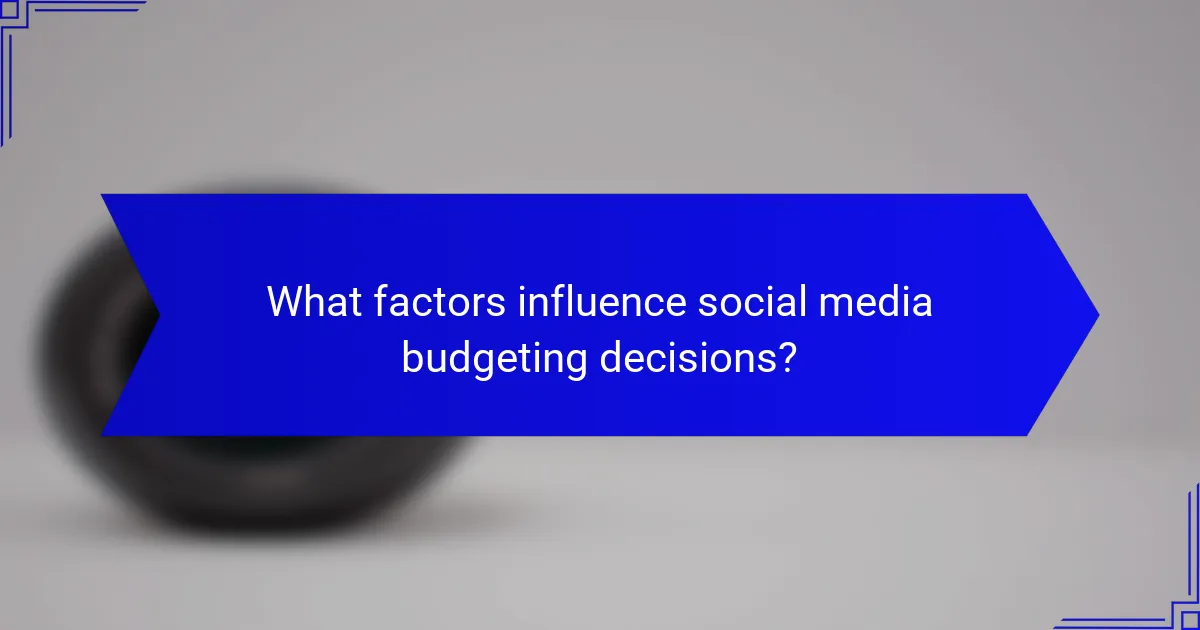Effective social media budgeting is crucial for maximizing return on investment and ensuring that resources are allocated efficiently. By understanding the varying costs associated with different platforms, content creation, and influencer partnerships, businesses can create a strategic budget that aligns with their marketing goals and adapts to market changes.

What are the best practices for social media budgeting?
Effective social media budgeting involves strategic planning to maximize return on investment. By following best practices, businesses can allocate resources efficiently and adapt to changing market conditions.
Define clear objectives
Establishing clear objectives is essential for effective social media budgeting. Objectives should align with overall business goals, such as increasing brand awareness, generating leads, or driving sales. For example, a company might aim to boost website traffic by 30% over six months through targeted social media campaigns.
When defining objectives, consider using the SMART criteria: Specific, Measurable, Achievable, Relevant, and Time-bound. This approach ensures that goals are realistic and provides a framework for evaluating success.
Allocate funds based on platform performance
Allocating funds based on platform performance helps ensure that resources are directed where they yield the best results. Analyze the effectiveness of each social media channel by tracking metrics such as engagement rates, conversion rates, and cost per acquisition.
For instance, if Facebook ads generate a higher return compared to Instagram, consider increasing the budget for Facebook while reducing spending on less effective platforms. Regularly reviewing performance data allows for informed adjustments to the budget allocation.
Monitor and adjust spending regularly
Regular monitoring and adjustment of spending are crucial for optimizing social media budgets. Set up a schedule to review performance metrics and budget allocations, ideally on a monthly basis. This practice helps identify trends and areas for improvement.
Be prepared to reallocate funds quickly in response to changes in performance or market conditions. For example, if a new trend emerges on TikTok that aligns with your brand, consider shifting some budget from underperforming channels to capitalize on the opportunity.

What are the costs associated with social media advertising?
The costs of social media advertising can vary significantly based on the platform, content creation, and influencer partnerships. Businesses should consider these factors to effectively budget for their campaigns and maximize return on investment.
Platform-specific advertising costs
Each social media platform has its own pricing structure for advertising. For instance, Facebook and Instagram typically operate on a pay-per-click (PPC) or cost-per-impression (CPM) basis, with average costs ranging from a few cents to several dollars per click, depending on targeting and competition.
LinkedIn tends to be more expensive, with costs often exceeding $5 per click due to its professional audience. Twitter and TikTok also have unique pricing models, generally falling within similar ranges but influenced by factors like audience engagement and ad formats.
Content creation expenses
Creating high-quality content is crucial for effective social media advertising and can incur various costs. Businesses may need to budget for graphic design, video production, copywriting, and photography, which can range from a few hundred to several thousand dollars, depending on the complexity and quality required.
Utilizing in-house resources can reduce costs, but outsourcing to professionals often yields better results. It’s essential to balance quality with budget constraints to ensure content resonates with the target audience.
Influencer marketing fees
Partnering with influencers can enhance social media campaigns but comes with its own set of costs. Influencer fees can vary widely based on their follower count, engagement rates, and niche, with micro-influencers typically charging a few hundred dollars, while top-tier influencers may demand thousands or even tens of thousands per post.
When budgeting for influencer marketing, consider the potential return on investment and the influencer’s alignment with your brand values. Establish clear expectations and deliverables to ensure a successful partnership.

How to create a social media budget?
Creating a social media budget involves outlining your financial resources for marketing activities across various platforms. This budget should reflect your goals, target audience, and past performance to ensure effective allocation of funds.
Identify target audience
Understanding your target audience is crucial for effective budgeting in social media. Identify demographics such as age, gender, location, and interests to tailor your content and advertising spend.
Utilize tools like Facebook Insights or Google Analytics to gather data on your audience. Knowing who you are targeting helps in prioritizing platforms and types of content that resonate best with them.
Analyze past campaign performance
Reviewing past campaign performance provides insights into what worked and what didn’t. Look at metrics such as engagement rates, conversion rates, and return on investment (ROI) to inform your future budget decisions.
Consider creating a simple table to compare the performance of different campaigns. This can help you identify trends and allocate funds more effectively in future initiatives.
Set a realistic budget range
Establishing a realistic budget range is essential for successful social media marketing. Depending on your business size and goals, a typical budget might range from a few hundred to several thousand dollars per month.
Factor in costs for content creation, paid advertising, and any tools or software you may need. Regularly review and adjust your budget based on performance and changing business objectives to ensure optimal use of resources.

What are the alternatives to traditional social media advertising?
Alternatives to traditional social media advertising include organic strategies, content marketing, and email marketing. These methods can effectively engage audiences without the costs associated with paid ads.
Organic social media strategies
Organic social media strategies focus on building a community and engaging with followers without paid promotions. This can involve posting regular updates, responding to comments, and sharing user-generated content. The goal is to create authentic interactions that foster loyalty and brand awareness.
To implement organic strategies, consider posting consistently, using relevant hashtags, and collaborating with influencers in your niche. Track engagement metrics to understand what resonates with your audience and adjust your approach accordingly.
Content marketing initiatives
Content marketing initiatives involve creating valuable content that attracts and retains a target audience. This can include blog posts, videos, infographics, and podcasts that provide useful information or entertainment. The focus is on establishing authority and trust rather than direct selling.
When developing content, ensure it aligns with your audience’s interests and needs. Utilize SEO best practices to increase visibility and consider repurposing content across different platforms to maximize reach. Regularly analyze performance to refine your strategy.
Email marketing integration
Email marketing integration allows you to communicate directly with your audience and nurture leads over time. By collecting email addresses through sign-ups or promotions, you can send personalized content, updates, and offers that encourage engagement and conversions.
To effectively integrate email marketing, segment your audience based on interests or behaviors and tailor your messages accordingly. Use compelling subject lines and clear calls to action to increase open and click-through rates. Monitor metrics like open rates and conversions to optimize your campaigns.

How to measure the ROI of social media spending?
Measuring the ROI of social media spending involves evaluating the financial return generated from your investments in social media marketing. Key metrics include engagement, conversions, and overall impact on sales or brand awareness.
Track engagement metrics
Engagement metrics such as likes, shares, comments, and click-through rates provide insights into how well your content resonates with your audience. High engagement often correlates with increased brand loyalty and customer retention.
To effectively track these metrics, use social media platforms’ built-in analytics tools. Set benchmarks based on your industry standards to gauge performance over time.
Calculate conversion rates
Conversion rates measure the percentage of users who take a desired action after interacting with your social media content. This could include signing up for a newsletter, making a purchase, or downloading a resource.
To calculate conversion rates, divide the number of conversions by the total number of visitors from social media, then multiply by 100. A conversion rate of 2-5% is often considered average, but this can vary widely by industry.
Use analytics tools like Google Analytics
Google Analytics is a powerful tool for measuring the ROI of social media spending. It allows you to track user behavior on your website, including traffic sources, bounce rates, and goal completions.
Set up UTM parameters for your social media links to gain deeper insights into which campaigns drive the most traffic and conversions. Regularly review your analytics to adjust your strategy based on what is working best.

What factors influence social media budgeting decisions?
Social media budgeting decisions are influenced by various factors including industry benchmarks, audience demographics, and overall marketing objectives. Understanding these elements helps businesses allocate resources effectively to maximize their social media impact.
Industry benchmarks
Industry benchmarks provide a reference point for social media spending based on what similar businesses allocate. For instance, companies in the retail sector may spend around 10-15% of their marketing budget on social media, while those in technology might allocate slightly less. These benchmarks can vary significantly depending on the industry and market conditions.
To effectively use industry benchmarks, compare your spending with competitors and adjust based on your unique goals. Regularly reviewing these benchmarks ensures that your budget remains competitive and aligned with industry standards.
Audience demographics
Understanding audience demographics is crucial for effective social media budgeting. Different age groups, locations, and interests dictate where and how much to spend. For example, targeting younger audiences may require higher investment in platforms like TikTok or Instagram, while older demographics might respond better to Facebook or LinkedIn.
To optimize your budget based on demographics, conduct thorough market research to identify your target audience’s preferences. This helps in tailoring content and ad spend to platforms that yield the best engagement and return on investment.
